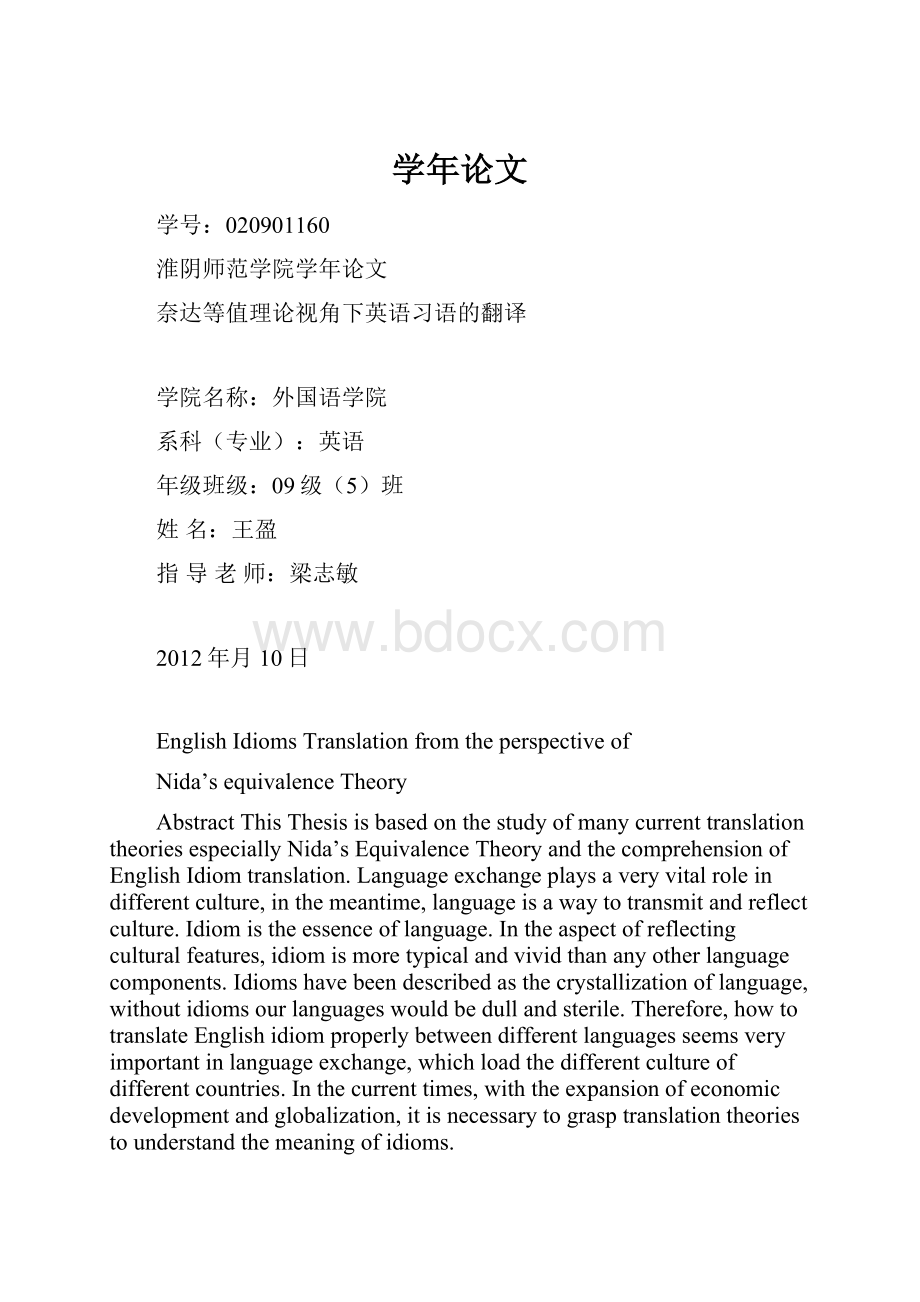学年论文.docx
《学年论文.docx》由会员分享,可在线阅读,更多相关《学年论文.docx(9页珍藏版)》请在冰豆网上搜索。

学年论文
学号:
020901160
淮阴师范学院学年论文
奈达等值理论视角下英语习语的翻译
学院名称:
外国语学院
系科(专业):
英语
年级班级:
09级(5)班
姓名:
王盈
指导老师:
梁志敏
2012年月10日
EnglishIdiomsTranslationfromtheperspectiveof
Nida’sequivalenceTheory
AbstractThisThesisisbasedonthestudyofmanycurrenttranslationtheoriesespeciallyNida’sEquivalenceTheoryandthecomprehensionofEnglishIdiomtranslation.Languageexchangeplaysaveryvitalroleindifferentculture,inthemeantime,languageisawaytotransmitandreflectculture.Idiomistheessenceoflanguage.Intheaspectofreflectingculturalfeatures,idiomismoretypicalandvividthananyotherlanguagecomponents.Idiomshavebeendescribedasthecrystallizationoflanguage,withoutidiomsourlanguageswouldbedullandsterile.Therefore,howtotranslateEnglishidiomproperlybetweendifferentlanguagesseemsveryimportantinlanguageexchange,whichloadthedifferentcultureofdifferentcountries.Inthecurrenttimes,withtheexpansionofeconomicdevelopmentandglobalization,itisnecessarytograsptranslationtheoriestounderstandthemeaningofidioms.
Keywords:
Englishidiomtranslation;culturaldifference;equivalencetheory;culturalcompetitiveness
摘要本文主要基于奈达的等值理论去理解英语习语的汉译。
语言交流在不同文化中起到相当大的作用,同时语言也是传达和反映文化的一种途径。
习语是语言的精髓。
从反映文化特点的角度来看,习语比其他任何语言成分都要典型和形象。
习语曾被描述成语言的结晶,没有习语的存在,语言就会变得枯燥无味!
因此,如何准确地翻译英语习语在语言交流中显得尤为重要,语言交流承载着不同国家的不同文化。
在当今这个时代,文化竞争力在综合国力中发挥越来越大的作用,掌握一些翻译理论对于理解习语的意思很有必要。
关键词:
英语习语的翻译;文化差异;等值理论;文化竞争力;
1.Introduction
2.LiteratureReview
2.1CurrentResearchesonEnglishIdiomTranslation
2.2CurrentResearchesonNida’sEquivalenceTheory
Fromtheearly1960stothe1980s,Nida’sEquivalenceTheoryisthecoreofwesterntranslationtheories.IthasagreatimpactonwesterntranslationtheoristsandenjoysgreatpopularitybothinGermanyandinUnitedStates(MaHuijuan58).
AlthoughNida’stranslationtheorywasverypopularbefore1980s,manywesterntranslationscholarsstartedtocriticizehistheoryfrommanyvariousperspectives,Nida’sEquivalenceTheorywasrejectedbysomewesternscholars.
BassnettcitedtwoexamplesofNidatomanifestthathiscategoriesof“dynamicequivalence”and“formalequivalence”were“actuallyconflictwitheachother”andwerelooselydefined(Ma,Huijuan62).NewmarkdisapprovedofNida’sassumptionthatalltranslatingwascommunicating,andtheoverridingprincipleofanytranslationwastoachieve“equivalenteffect”.Inhisopinion,equivalenteffectwas“thedesirableresult,ratherthantheaimofanytranslation”(Ma,Huijuan63).
VenuticonsideredNida’s“dynamicequivalence”themosttypicaldomesticatingtheoryandNidawasaccusedofcarryingourculturalhegemonism(Ma,Huijuan68).
WhenNida’sEquivalenceTheorywasintroducedintoChinain1980s,itwongreatpraise.ThereweresomebooksthatpromotedthespreadofNida’stranslationtheory.NidaonTranslationbyTanZaixi,aChineseversionofTowardaScienceofTranslating(1964)andTheTheoryandPracticeofTranslation(1969).OnTranslation:
withSpecialReferencestoChineseandEnglish,co-authoredbyJinDiandNida;InSearchofthePrinciplesofEquivalenceEffectbyJinDi.
Fromthelate1980s,moreandmoreChinesetranslationscholarsbegantodenyNida’stranslationtheory,especiallyitsapplicablilitytotranslatingpracticebetweenChineseandforeignlanguages.Thedebatesfocusontheresponseofreaders.AnotherproblemscholarsconsideredistheculturalfactorsthatNida’sTranslationTheoryinvolved(XuJun).WuYicheng,LiuYingkai,LiuJun,Wang,DongfengaretherepresentativeswhodeniedNida’stheory.
Toconclude,Chinesescholars’attitudestowardNida’sTheoryhavechangedastimegoeson.
3.BriefIntroductionofNida’sEquivalenceTheory
EugeneA.NidaisafamousAmericantranslationtheoristaswellasalinguist.HistranslationtheoryhasagreatimpactontranslationstudiesinbothwesternandChina.AlthoughmanyscholarscriticizeevenrejectNida’stheory,histranslationtheoryhasgainedtremendouspopularityallovertheworld.
3.1NidaandHisMajorTheory
EugeneA.Nidadevotedhiswholelifetothestudyoftranslationandlinguisticsandhis“scienceoftranslation”,“dynamicequivalence”,“functionalequivalence”makegreatcontributiontotheworldtranslationfield.
3.1.1AboutEugeneA.Nida
EugeneA.NidawasborninOklahomaCityCentralSouthoftheUnitedStates,onNovember11,1914.HewasintenselyinterestedinChristandlanguages.AftergraduatingfromtheUniversityofCaliforniain1936,heattendedCampWycliffe,whereBibletranslationtheorywastaught.In1937,hestudiedintheUniversityofSouthCalifornia,whereheobtainaMasterDegreeinNewTestamentGreekin1939.In1943,NidareceivedhisPh.D.inLinguisticsfromtheUniversityofMichigan,andinthesameyear,hecommencedhiscareerasalinguistintheAmericanBibleSociety.HewasquicklypromotedandthenworkedasExecutiveSecretaryforTranslationsuntilhisretirement.
3.1.2Nida’sMajorTheories
ThedevelopmentofNida’stranslationideasconsistsofthreestages:
thelinguistictheoryintheearlystage,thecommunicativetranslationtheoryandsocialsemioticstheoryinthelatestage.
ThefirststagebeganwithhisdoctoraldegreedissertationEssentialsofEnglishGrammarandendedwithprinciplesofTranslationasExemplifiedbyBibleTranslationinBrower’sDissertationCollectionOnTranslationin1959.Duringthisperiod,hestudiedtranslationmainlyintermsofsyntax,morphologyandsemanticmeaning.
3.2EssenceofEquivalenceTheory
InTowardaScienceofTranslating(1964),Nidadistinguishestwokindsofequivalence:
formalequivalenceanddynamicequivalence.
AnimportantconceptinNida’stranslationtheory“dynamicequivalence”wasfirstputforwardinTowardaScienceofTranslating(1864)andelaboratedinTheTheoryandPracticeofTranslation(1969)indetail.Lastly,itwassubstitutedwith“functionalequivalence”.dynamicequivalencederivedfrom“theprincipleofequivalenceeffect”postulatedbyRieuandPhillips(Nida,1964:
159).
InNida’sbookTheTheoryandPracticeofTranslation,Nidadefinedtranslationasfollow:
“Translatingconsistsinproducinginreproducinginthereceptorlanguagetheclosestnaturalequivalentofthesourcelanguagemessage,firstintermsofmeaningandsecondlyintermsofstyle.”(Nida,Taber,196912)
Fromthedefinition,wecaninferthatthe“closest”equivalenceandthe“natural”equivalencearetheessenceofEquivalenceTheory.The“closestequivalence”canbeseenfromtherespectofform.Formisanimportantpartintranslation,andifitreproducedsuccessfully,theclosestequivalencebetweenthesourcelanguageandthetargetlanguagewillberealized.Thenaturalequivalencecanbeseenfromtherespectofmeaningandstyle.
3.3ThecontentsofEquivalenceTheory
LiuMiqinghasmentionedthatNida’sresearchofequivalencewasbasedonthetranslationofTheBible.HesaidthatNida’sequivalencecamefrom“aestheticsofreception”andemphasizedontheresponseofreceivers.
3.3.1FormalEquivalence
3.3.2FunctionalEquivalence
4.ABriefDescriptionofEnglishIdioms
Idiomistheessenceoflanguage.Itconsistsofplentifulsocialandculturalconnotation.Itisknowntoallthatidiomsaremainlyformedbypeopleduringtheirdailylifeandexperience.Forexample,“ploughthesand”isinnatureaboutagriculture;“neckandneck”isfromhorseracing;“aliveandkicking”isoutoffishing.
4.1DefinitionsofEnglishIdiom
AccordingtotheOxfordAdvancedLearner’sDictionary,idiomis“phraseorsentencewhosemeaningisnotobviousthroughknowledgeoftheindividualmeaningoftheconstituentwordsbutmustbelearntasawhole.”Generallyspeaking,“idiomconsistsofsetphraseandshortsentences,whicharepeculiartothelanguageinquestionandloadedwithnativecultureandideas”(Zhang162).
4.2CharacteristicsofEnglishIdiom
4.2.1长期的实用性
Idiomisaspecialkindoflanguagethatwasformedfrompeople’spracticeanddailylife.Wecanfindthatmanyidiomsemergedfromalongtimeago,evenfromtheancienttime.Althoughtheyare“old”,westillusethemfrequentlyinourcommunication.Forexample,
Romewasnotbuiltinaday.伟业非一日之功
worthone’ssalt称职
GodafflictsthosewhomHeloves(彭庆华27).
Englishidiomsarecustomarypractice,Forexample,靠记忆是byheart而不是bymemory,becausetheGreeksthinkthattheheartisnotonlythefeelingsbelongtobutalsotheplacewhereintelligenceandmemorylocated.
4.2.2结构的固定性
ThefixityofstructureinEnglishidiomsmeansthateveryelementoftheidiomsarefixed,andtheycannotbeseparatedorreplaced.Forexample,livefromhandtomouth(勉强糊口),而不能写成livefromthehandtothemouth,或者写成livefromahandtoamouth.
4.2.3语义的整体性
Idiomsareusuallytheunitsofoverallmeaning.Theyarenotthewholemeaningofeachpartofthewholephraseorsentence.TheoverallmeaningofEnglishidiomsoriginatefrom英语习语的转义,mainlyrefertofigurativemeaningandassociativemeaning.Forexample,flyoffthehandle发脾气;onthenose准确无误。
4.2.4语义的多义性
ThemeaningofEnglishidiomsarepolysemy,whichdependonthecontext.Forexample,haveafieldday一般指特别忙绿,或特别愉快,但在不同的语境中,意义有所差别。
如:
(1)Whenthescandalfinallycameout,thepresshadafieldday.在丑闻最终被揭露时,新闻媒体紧张的忙碌了一阵。
(2)Thechildrenwerehavingafielddayatthebeach,swimminganddigging.孩子们在海滩上玩的非常开心,又是游泳又是挖沙坑的。
(3)Inaddressingamassmeeting,hehadafieldday.他在群众大会上发言,获得了意外成功。
(4)Nooneelselikedstrawberries,sowehadafieldday.别的人都喜欢吃草莓,所以我们吃的很痛快。
4.3EquivalenceTheoryEmbodiedinEnglishIdiomsTranslation
Translationinvolvesthetransmissionofculturalinformation,anditisbeneficialforthelanguagedevelopment.Itwillbeverydifficultfortranslatorstotranslat